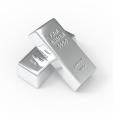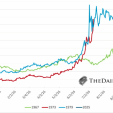The Yield Curve And Recession
The Federal Reserve (FED) has raised interest rates 7 times during its latest tightening cycle, after almost 10 years of its previous rate suppression binge.
What tended to have happened in previous interest rate tightenings is that shorter term interest rates have risen somewhat faster than long rates, and at some point, short rates catch up to and pass long rates. This rare situation is referred to as an ‘Inverted Yield Curve.’

One common way to measure this condition is by comparing the rate on 2 year Treasuries to the rate on 10 year Treasuries. Over the last 20 years, the 2 year rate has been above the 10 year rate 3 times, with a Recession following each of these yield curve inversions by several months.
The current 2 to 10 year Spread is around ¼ percent, having fallen considerably over the last 2 plus years. Many analysts are studying the possible approach of another soon to be Inversion and whether it portends another Recession and stock market crash. A good recent analysis is this one by Dan Amerman.
At the risk of tempting fate, I’d like to suggest a couple of reasons that ‘This time may be different.’
In previous cycles, the FED has worked its (nefarious) magic almost entirely at the short end, mainly with the very short maturity known as the FED Funds rate.
By contrast, this time around, the FED purchased almost $4 Trillion of long term Treasuries during its 3 (some say 4) bouts of Quantitative Easing. As part of the current rate hike cycle, the FED is starting to sell that hoard of long dated Treasuries. Its announced Quantitative Tightening speed is a half trillion dollars a year.

Add these sales to the Treasuries our government must sell to finance the approaching Trillion dollar deficits, and together, that’s a lot of selling pressure on the long end of the Treasury market, pushing prices down. Interest yields on bonds move opposite to bond prices, so all those sales should work to raise long rates considerably.
So, the FED is raising short rates, and the FED is raising long rates. The net result is that the 2-10 year Yield Spread very well might not become inverted during this rate hike cycle. How will that affect the prospects of a possible Recession? I don’t know – but at least it’s a question to consider.
Second, the occurrence of a Recession generally is measured by looking at real GDP. Real GDP is calculated by trying to identify which transactions in our Economy to include, adding them up, and then adjusting for some measure of how fast prices have been rising.
The process of counting the Nominal GDP is imperfect (to say the least) and intentionally leaves out a lot of economic activity.
And then, there is measuring price increases. New products are born all the time, others change (improve?), and others die in the marketplace. Consumer preferences change minute to minute – forget about over the course of a whole year – partly due to feature changes (computers), partly due to prices vs salaries (steak vs hamburgers), and partly for reasons a room full of statisticians would be hard pressed to understand.
The people who actually collect price data do an amazing job of it. However, those in charge of reporting the results have political reasons to adjust the data to make price increases appear lower rather than higher. A lower CPI looks better for political office holders. A lower CPI causes lower inflation adjustments for Social Security, etc saving tax money. And so on.
So, when nominal GDP is adjusted by artificially low CPI numbers, the ‘Real GDP’ that gets reported is artificially high.

There are several alternative ways to measure price increases, including the Chapwood Index and Shadow Stats. Both of these show much higher price increases – in the 10% per year range!
If we adjust the nominal GDP by either of these alternative measures, the result would indicate that GDP is MUCH lower, and that the US has been in Recession for the last 20 years or more.
My question then is, if we’ve been in Recession for the last 20 years, then what is an inverted yield curve telling us? That the Recession that we already are in is going to get worse?
As Benjamin Disraeli said, “There are lies, damned lies, and statistics.” They’re all we have, so it’s up to each of us to decide whether they are worth even considering or whether they are totally useless.
********






 Robert (Bob) Shapiro is self-taught in Austrian Economics and has consulted briefly for the governments of Mexico, Greece, Portugal and Spain. He has traded Gold & Silver and their stocks since 1970.
Robert (Bob) Shapiro is self-taught in Austrian Economics and has consulted briefly for the governments of Mexico, Greece, Portugal and Spain. He has traded Gold & Silver and their stocks since 1970. 










